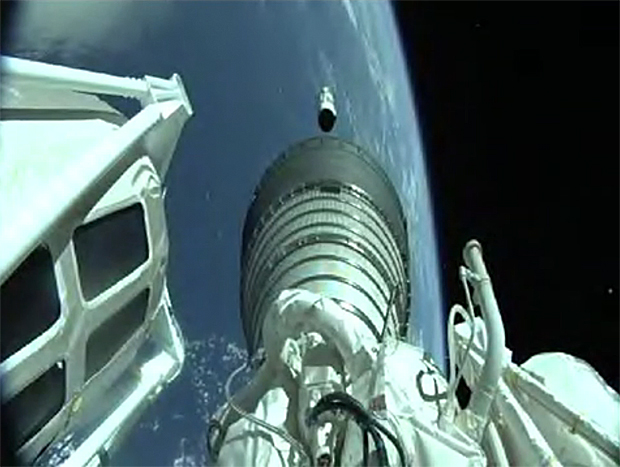Atlas 5 lifts latest GPS navigation satellite into orbit
A workhorse Atlas 5 rocket boosted the latest in a series of advanced Global Positioning System navigation satellites into space Saturday, putting on a spectacular Halloween sky show for area residents and tourists.
Under a sunny sky, the rocket's Russian-built RD-180 first-stage engine thundered to life at 12:13 p.m. EDT (GMT-4), throttled up to full power and majestically pushed the 19-story-tall booster away from its firing stand at the Cape Canaveral Air Force Station.
Initially climbing straight up, the Atlas 5 arced away to the east over the Atlantic Ocean, quickly accelerating as the RD-180, generating more than 860,000 pounds of thrust, consumed its load of kerosene and liquid oxygen propellants.
Pushing the rocket out of the dense lower atmosphere, the RD-180 shut down four minutes after liftoff, the first stage fell away and the flight continued on the power of the Centaur second stage's single Aerojet Rocketdyne RL10C engine.
Seventeen minutes after launch, the Centaur engine shut down, putting the payload into a preliminary elliptical orbit. A second firing three hours later was planned to finish the job, putting the Global Positioning System 2F-11 satellite into a circular 12,600-mile-high orbit.
The $245 million GPS block 2F-11 spacecraft is the 11th of 12 upgraded navigation beacons built by Boeing, part of a 31-satellite constellation that provides position and timing data allowing users on the ground, at sea or in the air to pinpoint their location, velocity and altitude with high precision.
"The GPS 2F vehicles are part of four generations of operational vehicles that are currently on orbit, which is a total of 31 operational satellites, the largest constellation in the Department of Defense," Air Force Col. Steve Whitney, director of the Global Positioning Systems Directorate, told reporters before launch.
He said two of the satellites in the current constellation are aging Block 2As, the oldest of which was launched 25 years ago on Nov 26, 1990.
"I have 23 lieutenants in the program office that are younger than the satellites on orbit," Whitney said.
GPS satellites operate in six orbital planes, arranged so that at least four spacecraft are above the horizon for users anywhere on the planet. The satellites continuously transmit ultra-precise atomic clock timing and position data that compact receivers can use to calculate a user's location, velocity and altitude.
Russia and China also operate fleets of navigation satellites, but the GPS system, which provides unencrypted data for public use, is the most heavily used system in the world.
"The GPS constellation is the most robust and capable system in (history), and the 2F satellites provide improved accuracy through better clocks, longer design life and a third civil signal for aviation and safety of life applications," Whitney said. "It also includes a more robust military signal. In fact, this launch will provide the 18th satellite on orbit with this improved military signal."
He said GPS technology is "the critical enabler for the U.S. military to provide national security and a worldwide service for billions of users around the globe. Modernization efforts are in progress and will continue the legacy of GPS as the gold standard for position, navigation and timing services."
This was the 59th launch of an Atlas 5, ULA's 11th flight so far this year and its 102nd since Boeing and Lockheed Martin formed the partnership in 2006.


